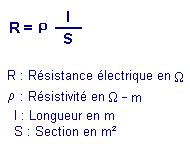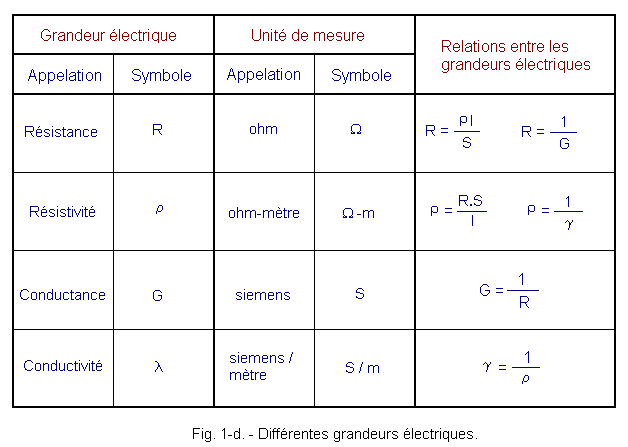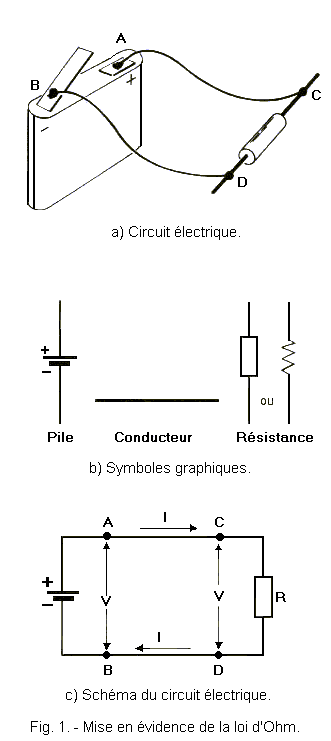
| |
||
Created it, 05/10/15
Update it, 05/11/24
N° Visitors
![]()
FOOT- NOTE :
The goal of electronics is to explain you certain rules which can help you in certain fields and in particular on the operation of the computers. We will start on different pages and in bottom of those, you will see a bond entitled “following Lessons or summary electronics” which will enable you to sail in order to guide itself and, to follow the lessons in the order corresponding. Therefore, We will begin with the law of Ohm then the law of Joule and well of others… Certain paragraphs are intended to the beginners.
We also advise you to begin the lessons of electronic fundamental the purpose of which is to include/understand the whole of the programs well while starting with the law of Ohm and while following the lessons in the order. Then, test your knowledge envisaged to this end so that you can realize of the exactitude of the lessons which you had learned before. You can choose the lessons of your choice for example digital electronics as well as the corresponding practice, (14 lessons and 14 practical digital). For making well, you must begin the 1st digital theoretical lesson then the 1st digital practical lesson, then, the 2nd theoretical lesson and the 2nd lesson of practice and so on to benefit from it fully from the education of this site.
![]()
![]() 1. - CONCEPT
OF RESISTANCE ELECTRIC
1. - CONCEPT
OF RESISTANCE ELECTRIC
Very electrical current in a driver is due to a displacement of electrons. During their displacement, these electrons meet obstacles due to the atoms of the driver.
A driver presents a certain opposition to the passage of the electrical current, opposition which is called electric resistance.
The concept of resistance electric can extend to any material, even with insulators insofar as those oppose to the displacement of the electric charges a so large resistance which it prevents almost any passage of current.
Resistance is classified among the electric quantities and has its unit.
1. 1. MEASURING UNIT OF ELECTRIC RESISTANCE
Electric resistance (symbol R) is measured in Ohm (W symbol).
W is the last letter of the Greek alphabet : Omega. To indicate the value of resistances, one frequently uses multiples of the Ohm such as the kiloohm (symbol kW) which is worth 1000 Ohms or the megohm (symbol MW) which is worth 1 million Ohms.
Resistance R of an electric driver is defined by three parameters :
its length
its section
its nature
1. 1. 1. - INFLUENCE OF SA LENGTH
It is obvious that the resistance met by the electric charges moving in a driver is all the more large as this driver is long, because the number of the atoms met by the loads on their way is more important.
The resistance of a driver is thus proportional to its length.
1. 1. 2. - INFLUENCE OF SA SECTION
The electric charges are driven all the more easily as the section of the driver is important. To imagine that, one can say that the electric charges have a more important space to move.
The resistance of a driver is thus inversely proportional to its section.
1. 1. 3. - NATURAL INFLUENCE OF SA AND CONCEPT OF RESISTIVITY
Two of the same drivers length and of the same section, but of nature different, i.e. made up from different materials (for example one coppers some, the other out of iron) have different electric resistances.
The difference between the electric properties of materials is characterized by their resistivity. The symbol of the resistivity is the Greek letter r (rhô) and its unit is the ohmmeter (W-m). Appear 1-a are gathered the resistivities of principal pure metals and alloys of everyday usage in electric technique.
| Metal | Resistivity with 20°C |
| Money | 1,6 x 10-8 W - m |
| Copper | 1,7 x 10-8 W - m |
| Aluminum | 2,8 x 10-8 W - m |
| Tungsten | 5,6 x 10-8 W - m |
| Iron | 9,6 x 10-8 W - m |
| Platinize | 10 x 10-8 W - m |
| Lead | 22 x 10-8 W - m |
| Mercury | 95 x 10-8 W - m |
| Alloy | Composition | Resistivity (in 10-8 W - m) |
| Brasses |
Cu 60 to 70% Zn 40 to 30% |
Between 5 and 10 |
| Copper nickel zinc alloy |
Cu 60% Zn 25% Nor 15% |
30 |
| Manganin |
Cu 85 % Mn 11 % Ni 4 % |
40 |
| Constantan |
Cu 60% Nor 40% |
50 |
| Ferronickel |
Fe 75% Nor 25% |
80 |
| Nickel-chromium |
Ni 65 % Fe 23 % Cr 12 % |
110 |
A small comment on these tables is
necessary, one realizes that the resistivity is not expressed in W-m
and this because this unit is too much large for the drivers. In the figure 1-a,
one uses hundred millionth ohmmeter (10-8
W-m).
But according to the works, you can find this resistivity expressed in µW-m
(microohm-meter) which is worth 10-6
W-m
or in µW-mm. Conversely for the insulators whose
resistivity is important one uses the megger (MW-m) which is worth
106
(1 million)
W-m.
As we have just seen it, the
electric resistance of a driver is defined by three parameters. We can thus
think that these parameters can be dependant between them by a relation making
it possible to determine the resistance of a given driver knowing its dimensions
and its nature.
We know already that this resistance
is proportional to the length :
R = f (l)
( We also know that this resistance is
inversely proportional to the section :
The resistivity of the driver also
intervenes in this calculation. The unit of resistivity being the ohmmeter;
thus, more the driver will be long plus the influence of its resistivity will be
felt on the displacement of the electrons thus on the resistance of conduction :
R = f (r)
Combination of the three preceding
relations, we can deduce the general formula to determine the resistance of a
driver :
Knowing this formula, we can as
example calculate the resistance which has a copper driver 100
m length and 1 mm² (10 To supplement our example, the
figure 1-c gives the resistance of 100 m length
drivers and 1 mm² of section but made out
of various materials, and this with an aim of carrying out a better comparative
analysis of these metals at the point of the electric sight.
Lastly, to close this chapter on
electric resistance, it should be known that this one varies with the
temperature because the resistivity of the substance also varies with the
temperature. However, all the substances do not react in an identical way. In
general, the resistivity increases when the temperature increases but in
different proportions according to the substances.
The alloys, although having a
resistivity more important than pure metals (figure 1-b), have on the other hand
a resistivity much more stable.
For example the manganin and the
constantan (what justifies the name given to this alloy) are particularly used
for the realization of calibrated resistances or the ohm-standards (resistances
especially built to represent as exactly as possible the unit of electric
resistance).
Some substances see, on the other
hand, their resistivity decreasing when the temperature increases and it is in
particular the case of certain mixtures of oxides or sulfides.
1. 2. -
CONDUCTANCE AND CONDUCTIVITY
Until now, we considered the drivers
from the point of view of the resistance which they oppose in the passing of the
current, but as its name indicates it, this driver is used to convey the current
of a point to another.
The aptitude of a driver to convey
the current more or less well is called the electric
conductance. A driver presents a all the more large conductance as
its resistance is low. The conductance will be thus the reverse of resistance.
The symbol of the conductance is G
and its unit is Siemens (symbol S).
As we defined a resistivity, we can
define a conductivity which is the reverse of the
resistivity.
G = 1 / r
The symbol of conductivity is g
(is read gamma, letter of the Greek alphabet) and its unit is Siemens
/ meter
(symbol S / m).
As we saw, we can call drivers all
the elements which present the property to be easily let cross by the current,
they thus have a high conductivity and offer a low resistance to this current:
it is in particular the case of copper wire used to carry out the connections in
the electric circuits.
In these circuits however it often
presents the need for opposing to the current a more or less high resistance,
this is obtained by the use of elements carried out starting from materials with
high resistivity.
These elements cannot be regarded
any more as drivers with whole share insofar as their specific role is to oppose
to the electrical current a given resistance.
For this reason, these elements are
called resistances and are characterized by
the resistance, expressed in ohm, which they
oppose to the current.
In the table of the figure 1-d are
gathered the four sizes which we have just examined. For each one of them are
deferred the unit, the symbol corresponding and the relations existing between
these sizes.
Most important of these sizes
without question resistance is because we can directly measure his value by
comparison with known elements, as we will see it in good time.
All the electric quantities relating to a circuit
are now defined. We know the tension, the current (or intensity) and resistance.
We can pass on to the examination of a complete circuit and to see which
influence have each one of these three sizes on its operation. Let us start with
the very simple circuit such as it is represented figure 1-a).
This circuit consists of a resistance connected
to a pile, the insertion of resistance is necessary so that the circuit presents
a well defined resistive value. Appear 1-a, the circuit components are
represented under their real aspect but during the examination of the electric
circuits one always considers the components under their aspect symbolic system.
We thus obtain the electric diagram of the
circuit to be analyzed. Appear 1-b are given the electric symbols of the
three components of our circuit, while the figure 1-c appears its electric
diagram The letters A, B, C
and D of the figures 1-a and 1-c indicate
the points where the two drivers connecting the pile and resistance are welded
onto these two elements. The part of the diagram on the left of points A
and B represents the internal circuit of the
pile while the part on the right of these same points represents the circuit
external with the pile, circuit consisted the drivers and resistance. On the figure 1-c, we can indicate the various
known electric quantities clearly. The tension obtained at the boundaries of the
pile between the points A and B
is indicated by its symbol V. This symbol is
registered between the two arrows which highlight point A
and B, points between which appears this
tension. The same tension V
is also present at the terminals of resistance R,
i.e. between the point C and D,
because the point (C) is connected directly
to the item (A) and thus has the same electric potential as this point
;
it is the same with the point D directly
connected to B. The resistance of the circuit external with the
pile is located by its symbol R. One takes
account only of the resistive value of resistance and one neglects those of the
drivers and the pile which are very weak. Lastly, the current which crosses the
circuit is indicated by its symbol (I) with
the arrow showing the direction of its displacement following the conventional
direction. We clearly see on this diagram that the current leaves the positive
pole of the pile, crosses the driver AC then
resistance R and returns to the negative
pole of the pile via driver DB. The existing tension V
at the boundaries of the pile tends to cause the flow of current I
while resistance R presents an obstacle at
its passage: it is understood that the intensity will depend on the
tension and resistance. In other words, it must exist a relation which binds
between them these three fundamental electric quantities. This relation was discovered by the German
physicist George Simon OHM (1789-1854) and was called law
of Ohm. The unit of resistance also bears the name of this physicist. Ohm could state its law following many
experiments and of meticulous measurements; to have an idea of the
process which it adopted, one can make some simple remarks. As the tension of the pile is the cause which
determines the flow of the current in the circuit, if
the tension is increased, one increases also the intensity of the current ;
one can easily check this fact by successively connecting to the circuit piles
which give tensions increasingly higher and by measuring the intensity of the
current that each one of them makes circulate, but one can go further. Indeed, if one divides the tension of each pile
by the intensity of the current which it makes circulate, one always finds the
same value; this value does not vary thus, although one varies the
tension, and also consequently the intensity of the current.![]() 1. 1. 4. - MEASUREMENT OF
THE ELECTRIC RESISTANCE OF DRIVER
1. 1. 4. - MEASUREMENT OF
THE ELECTRIC RESISTANCE OF DRIVER


.gif)
Metal
Resistance
of a 100 m length wire and 1 mm² of section
Money
1,6
W
Copper
1,7 W
Aluminum
2,8
W
Tungsten
5,6
W
Iron
9,6
W
Platinize
10 W
Lead
22 W
Mercury
95 W

![]() 2. - THE LAW
OF OHM
2. - THE LAW
OF OHM

![]()
| Following
page |